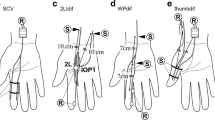Abstract
Motor conduction delay has been demonstrated in patients with carpal tunnel syndrome (CTS), however, there is also evidence that conduction slowing can be effected by other factors, e.g., the aging process. Recent development of the digital electroneurometer, a hand-held, battery-powered device for measuring motor nerve conduction time, has made this test available for CTS screening in industry. A cross-sectional study of 77 industrial workers was performed to determine the relationship between median motor nerve conduction time at the carpal tunnel and select personal factors. Motor nerve conduction time increased with age, length of employment, and weight. However, these variables accounted for only 20.3% of the variance in conduction time. The study indicates users of this device should be aware of these effects, and that other sources of variation must be identified and controlled if motor nerve conduction tests are to be used for CTS screening in industry.
Similar content being viewed by others
References
Simpson JA. Electrical signs in the diagnosis of carpal tunnel and related syndromes.J Neurol Neurosurg Psychiat 1956; 19: 275.
DeKrom MCTFM, Knipschild PG, Kester ADM, Spaans F. Efficacy of provocative tests for diagnosis of carpal tunnel syndrome.Lancet 1990; 335: 393–395.
Katz JN, Larson MG, Sabra A, Krarup C, Stirrat CR, Sethi R, Eaton HM, Fossel AH, Liang MH. The carpal tunnel syndrome: Diagnostic utility of the history and physical examination findings.Ann Intern Med 1990; 112: 321–327.
Spinner RJ, Bachman JW, Amadio PC. The many faces of carpal tunnel syndrome.Mayo Clin Proc 1989; 64: 829–836.
Stevens JC. AAEE minimonograph No. 26: The electrodiagnosis of carpal tunnel syndrome.Muscle Nerve 1987; 10: 99–113.
Grant KA, Congleton JJ, Koppa RJ, Lessard CS, Huchingson RD. Use of motor nerve conduction testing and vibration sensitivity testing as screening tools for carpal tunnel syndrome in industry.J Hand Surg 1992; 17: 71–76.
Osterman AL, Aversa BA, Greenstein D. Use of the Nervepace Electroneurometer as an Effective Screening Tool in the Diagnosis of Carpal Tunnel Syndrome. American Society for Surgery of the Hand, 44th Annual Meeting, Seattle, Washington, 1989.
Rosier RN, Blair WF. Preliminary Clinical Evaluation of the Digital Electroneurometer. Proceedings of the Instrument Society of America, Research Triangle Park, NC, pp. 55–58, 1984.
Steinberg DR, Gelberman RH, Rydevik B, Lundborg G. The utility of portable nerve conduction testing for patients with carpal tunnel syndrome: A prospective clinical study.J Hand Surg 1992; 17: 77–81.
Freund RJ, Littell RC.SAS system for regression. Cary, NC: SAS Institute, 1986.
Katz JN, Larson MG, Fossel AH, Liang MH. Validation of a surveillance case definition of carpal tunnel syndrome.Am J Public Health 1991; 81: 198–193.
Thomas JE, Lambert EH, Cseuz KA. Electrodiagnostic aspects of the carpal tunnel syndrome.Arch Neurol 1967; 16: 635–641.
Redmond MD, Rivner MH. False positive electrodiagnostic tests in carpal tunnel syndrome.Muscle Nerve 1988; 11: 511–517.
Dawson DM, Hallett M, Millender LH.Entrapment neuropathies (2nd Ed.). Boston: Little, Brown and Company, 1990.
Kemble F. Electrodiagnosis of the carpal tunnel syndrome.J Neurol Neurosurg Psychiat 1968; 31: 23–27.
Kimura J. Variability in nerve conduction measurement and carpal tunnel syndrome. InElectrodiagnosis in diseases of nerve and muscle: principles and practice. Philadelphia: F.A. Davis, 1984, pp. 494–496.
Campbell MG, Copp EP, James JL, Keenan J, Merry PH, Rudolfer SM. A comparison of normal limits arising in nerve conduction studies.Tohoku J Exp Med 1982; 173: 261–267.
Norris AH, Shock NW, Wagman IH. Age changes in the maximum conduction velocity of motor fibers of human ulnar nerves.J Appl Physiol 1953; 5: 589–593.
Rivner MH, Swift TR, Crout BO, Rhodes KP. Toward more rational nerve conduction interpretations: The effects of height.Muscle Nerve 1990; 13: 232–239.
Weber RJ. Motor and sensory conduction and entrapment syndromes. In Johnson EJ, ed.Practical electromyography (2nd Ed.). Baltimore: William & Wilkins, 1988.
Nathan PA, Keniston RC, Myers LD, Meadows KD. Obesity as a risk factor for slowing of sensory conduction of the median nerve in industry.J Occup Med 1992; 34: 379–383.
Winn FJ, Krieg EF. A regression model for carpal tunnel syndrome.PSEBM 1989; 192: 161–165.
Cook TM, Rosecrance JC, Brokeman SJ, Rulon AS, Wise CA. Reliability of a digital electroneurometer for the determination of motor latency of the median nerve.J Occup Rehab 1991; 1: 105–112.
Felsenthal G. Median and ulnar distal motor and sensory latencies in the same normal subject.Arch Phys Med Rehab 1977; 58: 297–302.
Author information
Authors and Affiliations
Rights and permissions
About this article
Cite this article
Grant, K.A., Congleton, J.J. & Koppa, R.J. Age and weight effects on motor nerve conduction time measurements in an asymptomatic industrial population. J Occup Rehab 2, 175–182 (1992). https://doi.org/10.1007/BF01078995
Issue Date:
DOI: https://doi.org/10.1007/BF01078995




